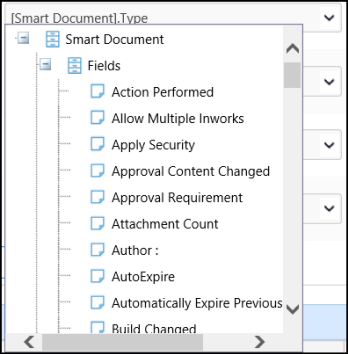Configuring Document Repository Search Columns
Once a new repository folder is created, the first step is to apply search columns. Search columns can be configured for any displayed or non displayed fields in each SmartSolve record. This includes any user defined fields added to SmartSolve records during implementation if additional fields were needed for more information and reporting.

- From the SmartSolve Portal Page, click the Administrator Tools tab.
- In the Settings section, click Document Repository Configuration.
Result: The Document Repositories list window is displayed. - Click the name of the repository to be configured.
Result: The repository configuration window is displayed. - Click the drop down arrow in the Search Columns field and select the column to be configured.
- Click the drop down arrow in the Condition field and select the search condition to be used for the search column:
| Condition | Definition |
|---|---|
|
Starts With |
Column values are compared against string, date, time stamp, numeric, and other literal values. |
|
Is Equal To |
Compares the equality of two expressions. |
|
Is Less Than |
Compares two expressions to determine whether the left expression has a value less than the right expression. |
|
Is Less Than or Equal To |
Compares two expressions to determine whether the left expression has a value less than or equal to the right expression. |
|
Is Greater Than |
Compares two expressions to determine whether the left expression has a value greater than the right expression. |
|
Is Greater Than or Equal To |
Compares two expressions to determine whether the left expression has a value greater than or equal to the right expression. |
|
Contains |
Supports complex searches for terms in record text columns (for example, title, contents). Can search for inflected forms of the search terms, test for proximity of the terms, and perform logical comparisons. Search terms can include wildcard characters. NOTE: Do not use with larger lists as this predicate could degrade the query's performance. |
|
Not Equal To |
Compares two expressions to determine whether the left expression is not equal to the right expression. |
|
Ends With |
Column values are compared against string, date, time stamp, numeric, and other literal values. NOTE: Do not use with larger lists as this predicate could degrade the query's performance. |
|
Is Null |
Determines if a query expression is null. Column values that are undefined at this time for the record can be detected using the NULL predicate. NOTE: Search queries using the NULL predicate can require that SmartSolve© Search scan the entire content index, which may degrade the query's performance. |
|
Is Not Null |
Determines if a query expression is not null. |
- Enter a value in the Search Value field.
| Default Search Value | Definition |
|---|---|
|
{UserContext. Actor Code} |
To filter the data by logged actor's code, viewing the saved search. |
|
{UserContext. Actor OrgUnitCode} |
To filter the data by logged on actor’s Department, viewing the saved search. |
|
AddDays(0) |
Show range of records based only on date parameter and number of positive or negative days defined. |
|
{[Param1]} |
Used for parameterized query. For example, check for duplicate exception records for a specific Org Unit and Part Number.
Step 1 - Create the Saved Search List. Step 2 - Add the Org Unit column.
Step 3 - Add the Part Number column.
Step 4 - Save the Saved Search list. Step 5 - Identify the Saved Search form name. View the Saved Search list to identify the form name listed in the URL. Product Exception Form Name = PXP_PRODUCT_QXPS_MAIN.ASPX
Step 6 - Define the following Form Config Properties:
Example: <%#String.format("PXP_PRODUCT_QXPS_MAIN.ASPX? QueryID={0}&OrgUnit={1}&PartNumber={2}","0000000000000000000010000", GetCurrentValue("_ctl1:QXP_ORU_CODE"),GetCurrentValue ("_ctl1:PXP_PRODUCT_CODE"))%> |
- Click the drop down arrow and select ) if you want to close this condition.
- Click the drop down arrow and select the appropriate boolean operator, And or Or.
- Click the drop down arrow in the Allow Editing field and specify Yes or No. The following table defines the predefined templates for the Allow Editing option:
| Option | Definition |
|---|---|
|
Yes |
The Yes option allows the end user to modify this search parameter from the Advanced Search view. For example, if you want the end user to enter their own search value in the advanced search, select Yes. In the example below, an advanced search was created to show a list of records by Short Description which contains the value that will later be entered by the end user viewing this advanced search.
|
|
No |
The No option locks in the search value entered under the Advanced Search setup and will not allow a user to modify the search value when the advanced search is later viewed. In the example below, an advanced search was created to show a list of records by Status which Is Equal To OPEN and cannot be changed by the end user viewing this advanced search. The Is Equal To condition is grayed out and will not allow the end user to change the search condition or enter a search value.
|
- Add more search columns as necessary.
- Once complete, click the Save button.
Result: The search columns have been configured.
Search Columns Example

See Also
Creating Document Repositories
Managing Document Repository Folders
Configuring Document Repository Sort Order
Configuring Document Repository Export Options
Configuring Document Repository Distribution Lists
Publishing a Document Repository

